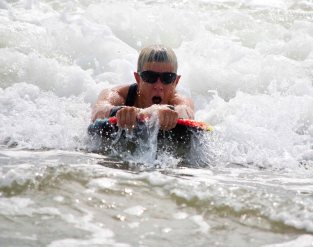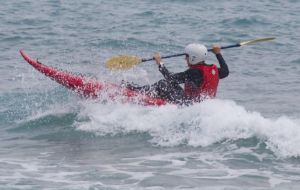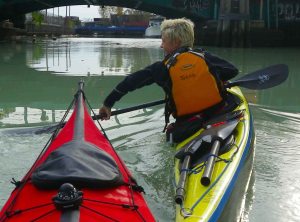By Johna Till Johnson
Photos by Vladimir Brezina
I’m not athletic.
Or at least, I never thought I was. True, I’d been on a couple of teams when I was young (fencing, swimming) and been told I had “potential”.
But the formative comment on my athletic abilities came from a gymnastics coach when I was 8: “She hasn’t got it.”
By “it” he meant “kinesthetic sense”—that ability to know exactly where your body is and what it’s doing at every moment. It’s an ability that’s foundational for most athletic endeavors.
The coach was right—I didn’t have it, and I could see its lack in my everyday life.
I fell off things, or tripped and landed face-forward (my lower lip has been split so many times my dentist is in awe of the scar tissue). Especially early on, I could drive my kayak coaches to despair with my inability to understand basic movements: “Move the blade up, Johna… no, UP… Johna, just LOOK at me!”
So I internalized that lack, and for a while it defined me. I had many other strengths, but no kinesthetic sense—or so I thought.
Here’s what I didn’t know then, and know now: Kinesthetic sense—and with it, athletic ability—can be learned.
Sure, there are prodigies who have it at birth, and many more in whom it develops rapidly with just a minimum of encouragement. Like other human abilities, athletic talent appears to be distributed along a spectrum.
But for those of us on the “don’t have it” end of the spectrum, it’s possible to develop it by thinking about your body, what it does, and how it moves.
A revelatory moment came last year when I was taking CrossFit classes. The coach was a wool-cap-wearing tattooed guy in his 20s with interesting facial hair and the wiry body of a professional skateboarder.
“There’s one fundamental athletic motion, ” he told me, and demonstrated it: Driving your body upwards using your legs as a spring, straightening your bent knees and driving from your heels.
Damn if he wasn’t right! It’s the classical motion of kayaking (driving your heels forward to propel the boat forward with your strokes). But you also see it in practically every other sport, from basketball to golf to rock-climbing. To get it right, everything has to be in proper alignment (heels, knees, back, shoulders) and even the positions of your toes and your neck matter.
CrossFit taught me to pay attention to form, because the coaches encouraged us to do weighted squats—and if you do squats with poor form, you blow out your knees (and potentially create insurance liabilities for the CrossFit gym). Good coaches are therefore dogmatic about teaching you the right form.
So I spent hours watching myself in the mirror, lifting weights and struggling with chinups and situps. I’d shut my eyes and try to feel where my knees, toes, and shoulders were—then open my eyes and see how close I’d guessed.
The attention to form paid off in kayaking—suddenly, I made progress in areas that had been baffling to me in the past. And the more I thought about where my body was and what it was doing, the better I got.
I recently took up barefoot running, which is all about proper form. You have to think about curving your toes up (you want to land on the balls of your feet, shift your weight to your toes, and then to your heels). And you need to keep your neck relaxed and your shoulders back… and use that “fundamental athletic motion” to drive yourself along.
And for once in my life, I’ve found an athletic activity that’s easy for me. That attention to form feels natural, innate. No, I’m not fast—but my goal isn’t to be fast. If I’m moving, I’m going as fast as I need to. My goal is to develop the form and motion that will allow me to run as much as I want—and I don’t know how much that will be, yet.
What’s even more interesting, though, is how the whole experience has changed how I move my body in everyday life. I find myself doing the “drive” when I get up from a chair, or instinctively adjusting my balance as I climb the stairs, thinking about whether my center of gravity is over my heels or my toes. And my movements have gotten more graceful and confident—like those of the “natural” athletes I know.
I doubt that having a kinesthetic sense will ever be instinctive for me. And the coach was undoubtedly right—I would likely never have made it to the upper echelons of gymnastics.
But the fact that, as an adult, I can acquire “it” is eye-opening to me.
If someone who “hasn’t got it” can become athletic—what other seemingly impossible things might be possible, after all?






